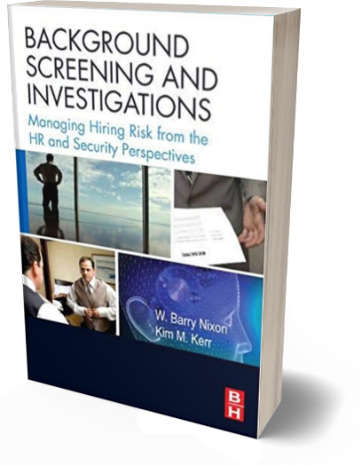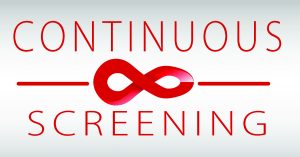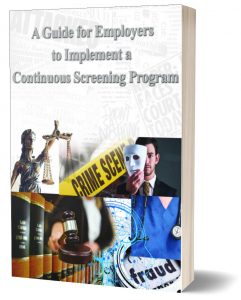CONTINUOUS SCREENING RESOURCE CENTER OLDSCREEN |
RESOURCE CENTER
This section includes the following resources:
- Continuous Screening library
- Infinity Screening: Never-Ending Background Screening, Chapter 8, Background Screening and Investigations: Managing Hiring Risk from the HR and Security Perspectives

Read Chapter 8 – Infinity Screening: Never-Ending Background Screening
Background Screening and Investigations: Managing Hiring Risk from the HR and Security Perspectives
Mar 19, 2008
By W. Barry Nixon SPHR and Kim Kerr CPP
Available on Amazon.com
- Continuous Screening Resources:
-
- Linkedin Group: Continuous Screening, Post Hire Screening, and Infinity Screening
- SlideShare: Continuous Screening Presentation
- Background screening firms that provide ‘Continuous Screening’ services (coming soon)
- Continuous Screening software platform providers (coming soon)
- A Guide For Employers to Implement Continuous Screening (a guide for HR and Hiring Managers)

“. . . Employers recognize that the single most important ingredient necessary to make a good hiring decision is to have high-quality information.”
W. Barry Nixon originated the term Continuous screening in 2006 when the database technology for being able to conduct on-going or reoccurring screening emerged. He saw the “handwriting on the wall” and that the die had been cast for significant change to occur in the background screening process.
Continuous screening is taking hold because employers are beginning to learn and understand that pre-hire detection of problem behavior is not enough to forestall or foretell future bad behavior that creates risk for an organization. Also, employers recognize that the single most important ingredient necessary to make a good hiring decision is to have high-quality information. Continuous Screening provides hiring managers with valuable information that positions them to be able to make the best possible decisions about employment actions that could mitigate risk to the enterprise.
It’s no surprise to any experienced manager that at the core of risk and threats to businesses are the people they employ. Employees account for a significant portion of risk including:
- Theft or embezzlement
- Identify theft
- Industrial espionage
- Data breaches
- Reputation damage
- Workplace violence
Along with understanding the reality of the risk and threat associated with hiring people, the technology that enables continuous screening to happen real-time has continued to progress as well. With the advent of cloud computing, the capabilities have leaped forward.
Rather than scanning one time, or on a regular schedule of intervals (such as every few years), organizations now have the power to perpetually evaluate risk post-hire as life events and identity data evolve. Using personnel risk assessment technology in a continuous screening model, sophisticated analytics can be unleashed to assess risk factors in real-time and proactively alert managers to potential issues before they escalate. A shift to continuous post-hire monitoring for the latest actionable information is now possible.
One example of a company using a software program to continuously check public records for everything from DUIs to bankruptcies, and alert officials when something happens to an employee that creates a potential risk. A company official shared,
“Continuous screening is taking hold because employers are beginning to learn and understand that pre-hire detection of problem behavior is not enough to forestall or foretell future bad behavior . . .”
“A company official shared, “If you go out and get a ticket for jaywalking, we don’t care, [however,] if you’re working in financial markets we may want to know about liens, judgments, civil actions that could indicate someone is in financial trouble and more likely to do something wrong.”
Before this same company began using the continuous monitoring software, they performed an initial background check when a person was hired and followed up with checks every three years after. By monitoring public records across the country, they are now alerted when a worker is arrested or convicted for an offense that would trigger concern for the employer, saving time and money by not having to conduct screens on workers who have no change in their status. “We re-screen only those who indicate to us through alerts that we need to look deeper,” he said. “The alerts find needles in haystacks for us.”
Alerts helped identify three workers who had died, uncovered a first-degree murder conviction for one worker and exonerated another worker whose brother had stolen his identity and was arrested.
Before the firm began checking public records, they wouldn’t have screened any of those people until they came back up on their periodic check.
Another case further illustrates the impact of using a continuous screening model on the ability to make pro-active informed decisions. Note the name of the actual firm in the case has been changed.
“A company official shared: “If you go out and get a ticket for jaywalking, we don’t care, (however,) if you’re working in financial markets we may want to know about liens, judgments, civil actions that could indicate someone is in financial trouble and more likely to do something wrong.”
The “Acme XYZ” company identified the following risk they were concerned about and wanted to find ways to mitigate these issues:
-
- Acme is bound to background screening standards that are based on the Department of Homeland Security (DHS) and Transportation Administration (TSA) lists of Disqualifying Criminal Offenses; in addition to the Fair Credit Reporting Act and the guidelines set by the Equal Employment Opportunity Commission (EEOC).
- Acme is required to conduct pre-screening and rescreening upon every three-year anniversary of more than 30,000 employees.
- Acme is concerned that their current background screening requirements, as well as the process, do not provide consistent, timely and accurate risk assessments per employee. Significant changes may occur during a three-year period which may impact the risk profile and ultimately impact employment eligibility. More frequent traditional background checks are cost-prohibitive.
- Acme has a policy requiring employees to self-report violations of their policies or significant life events, however, based on analysis of policy results the reporting policy is deemed ineffective.
“During the initial three-month period that the company used the continuous monitoring service, more than 800 potential problems were identified, of which there were 24 actionable alerts . . .”
The company implemented a trial of a ‘‘continuous monitoring service’’ that conducted continuous screening of their workforce and the outcomes produced are listed below.
During the initial three-month period that the company used the continuous monitoring service, more than 800 identity changes were identified, of which there were 24 actionable alerts that had the potential to disqualify the noted persons from continued employment in a sensitive position.
The following is a list of the actionable alerts received during the initial three months which were deemed disqualifying upon actual investigation.
Bookings/ Arrest
(1) Criminal possession, with intent to sell 10 lbs. marijuana
(3) Unnamed offenses
(1) Drug-related, intent to sell
Criminal-State
(1) Criminal possession of stolen property
(1) Criminal possession of a controlled substance
(1) Criminal possession of a weapon
(1) Robbery 2nd degree
(1) Assault 1st degree
(1) Injury/risk of injury to minor – sexual nature
(1) Felony possession of a controlled substance
(2) Receiving stolen property
(1) Endangered welfare of a child; photo sexual act
(1) Unnamed offense
Recorded Death
(3) Death
Sanctions
(4) Prohibition from working on NJ Government Contracts
Sex Offender
(1) Multiple sexual offenses
The level of risk associated with the “actionable alerts” clearly depends on the nature of the work and sensitivity of the job that is being performed, however, having the information positions the employer to be able to make an informed decision as opposed to getting blindsided by negative information.
These examples illustrate the true value of using a continuous screening model and show how real-time alerts can provide actionable information. Armed with this level of specific information, enterprise security managers are positioned to make decisions on how to best reduce or mitigate the risk when derogatory information is discovered about an employee.
“. . . The true value of using a continuous screening model is that real-time alerts provide specific actionable information on an employee to managers which positions them to make decisions on how to best reduce or mitigate the risk.”
It should be noted that it is important that firms using continuous screening understand that identifying derogatory information on an employee does not mean automatic termination and should simply be grounds for an investigation to ensue. This is where an individual assessment is very important, and all the relevant information needs to be examined, starting with is there a nexus between the negative information and the nature of the work being performed?
For example, the alert identifies that an employee has been convicted of robbery and their job is parking cars. It’s a clear nexus between the two and finding the employee another position or termination might be in order. Whereas, an employee convicted for possession of child pornography that works on a manufacturing production line would be a steeper hill to climb in showing a nexus between the two, despite how much disdain you might have for the wrongdoing. The point being is that each case must be handled based on the unique circumstance and variables that are relevant to the situation, and above all, avoid blanket policies.
It is also strongly recommended that before you take any actions be sure to get your Human Resources personnel involved and consult your company attorney. Managing employee situations and possible adverse actions have many more nuances involved versus when you are dealing with an external applicant.
Continuous screening takes background screening to another level and turns it into a real-time information gathering threat management and risk mitigation tool.
Reference: The content in this article is based on Chapter 8 of Background Screening &
Investigations: Managing Hiring Risk from an HR and Security Perspective, by W. Barry Nixon and Kim Kerr. See https://www.securitymagazine.com/articles/87383-the-emergence-of-infinity-screening-to-mitigate-risk



